Urry D.W. (Ed.) What Sustains Life? : Consilient Mechanisms for Protein-Based Machines and Materials
Подождите немного. Документ загружается.

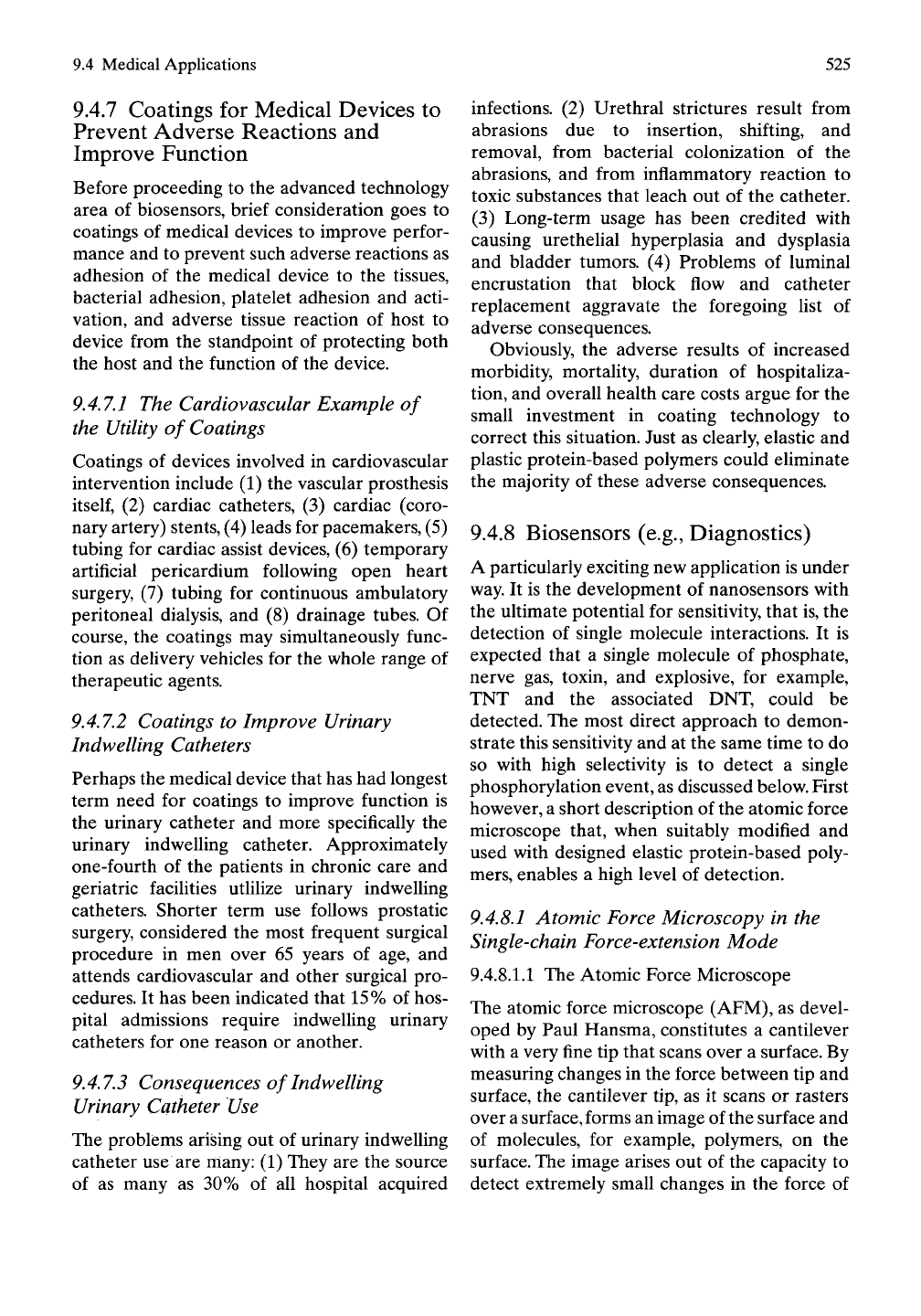
9.4 Medical Applications
525
9.4.7 Coatings for Medical Devices to
Prevent Adverse Reactions and
Improve Function
Before proceeding to the advanced technology
area of biosensors, brief consideration goes to
coatings of medical devices to improve perfor-
mance and to prevent such adverse reactions as
adhesion of the medical device to the tissues,
bacterial adhesion, platelet adhesion and acti-
vation, and adverse tissue reaction of host to
device from the standpoint of protecting both
the host and the function of the device.
9.4.7.1 The Cardiovascular Example of
the Utility of Coatings
Coatings of devices involved in cardiovascular
intervention include (1) the vascular prosthesis
itself,
(2) cardiac catheters, (3) cardiac (coro-
nary artery) stents, (4) leads for pacemakers, (5)
tubing for cardiac assist devices, (6) temporary
artificial pericardium following open heart
surgery, (7) tubing for continuous ambulatory
peritoneal dialysis, and (8) drainage tubes. Of
course, the coatings may simultaneously func-
tion as delivery vehicles for the whole range of
therapeutic agents.
9.4.7.2 Coatings to Improve Urinary
Indwelling Catheters
Perhaps the medical device that has had longest
term need for coatings to improve function is
the urinary catheter and more specifically the
urinary indwelling catheter. Approximately
one-fourth of the patients in chronic care and
geriatric facilities utlilize urinary indwelling
catheters. Shorter term use follows prostatic
surgery, considered the most frequent surgical
procedure in men over 65 years of age, and
attends cardiovascular and other surgical pro-
cedures. It has been indicated that 15% of hos-
pital admissions require indwelling urinary
catheters for one reason or another.
9.4.7.3 Consequences of Indwelling
Urinary Catheter Use
The problems arising out of urinary indwelling
catheter use are niany: (1) They are the source
of as many as 30% of all hospital acquired
infections. (2) Urethral strictures result from
abrasions due to insertion, shifting, and
removal, from bacterial colonization of the
abrasions, and from inflammatory reaction to
toxic substances that leach out of the catheter.
(3) Long-term usage has been credited with
causing urethehal hyperplasia and dysplasia
and bladder tumors. (4) Problems of luminal
encrustation that block flow and catheter
replacement aggravate the foregoing list of
adverse consequences.
Obviously, the adverse results of increased
morbidity, mortality, duration of hospitaliza-
tion, and overall health care costs argue for the
small investment in coating technology to
correct this situation. Just as clearly, elastic and
plastic protein-based polymers could ehminate
the majority of these adverse consequences.
9.4.8 Biosensors (e.g., Diagnostics)
A particularly exciting new application is under
way. It is the development of nanosensors with
the ultimate potential for sensitivity, that is, the
detection of single molecule interactions. It is
expected that a single molecule of phosphate,
nerve gas, toxin, and explosive, for example,
TNT and the associated DNT, could be
detected. The most direct approach to demon-
strate this sensitivity and at the same time to do
so with high selectivity is to detect a single
phosphorylation event, as discussed below. First
however, a short description of the atomic force
microscope that, when suitably modified and
used with designed elastic protein-based poly-
mers,
enables a high level of detection.
9.4.8.1 Atomic Force Microscopy in the
Single-chain Force-extension Mode
9.4.8.1.1 The Atomic Force Microscope
The atomic force microscope (AFM), as devel-
oped by Paul Hansma, constitutes a cantilever
with a very fine tip that scans over a surface. By
measuring changes in the force between tip and
surface, the cantilever tip, as it scans or rasters
over a surface, forms an image of the surface and
of molecules, for example, polymers, on the
surface. The image arises out of the capacity to
detect extremely small changes in the force of
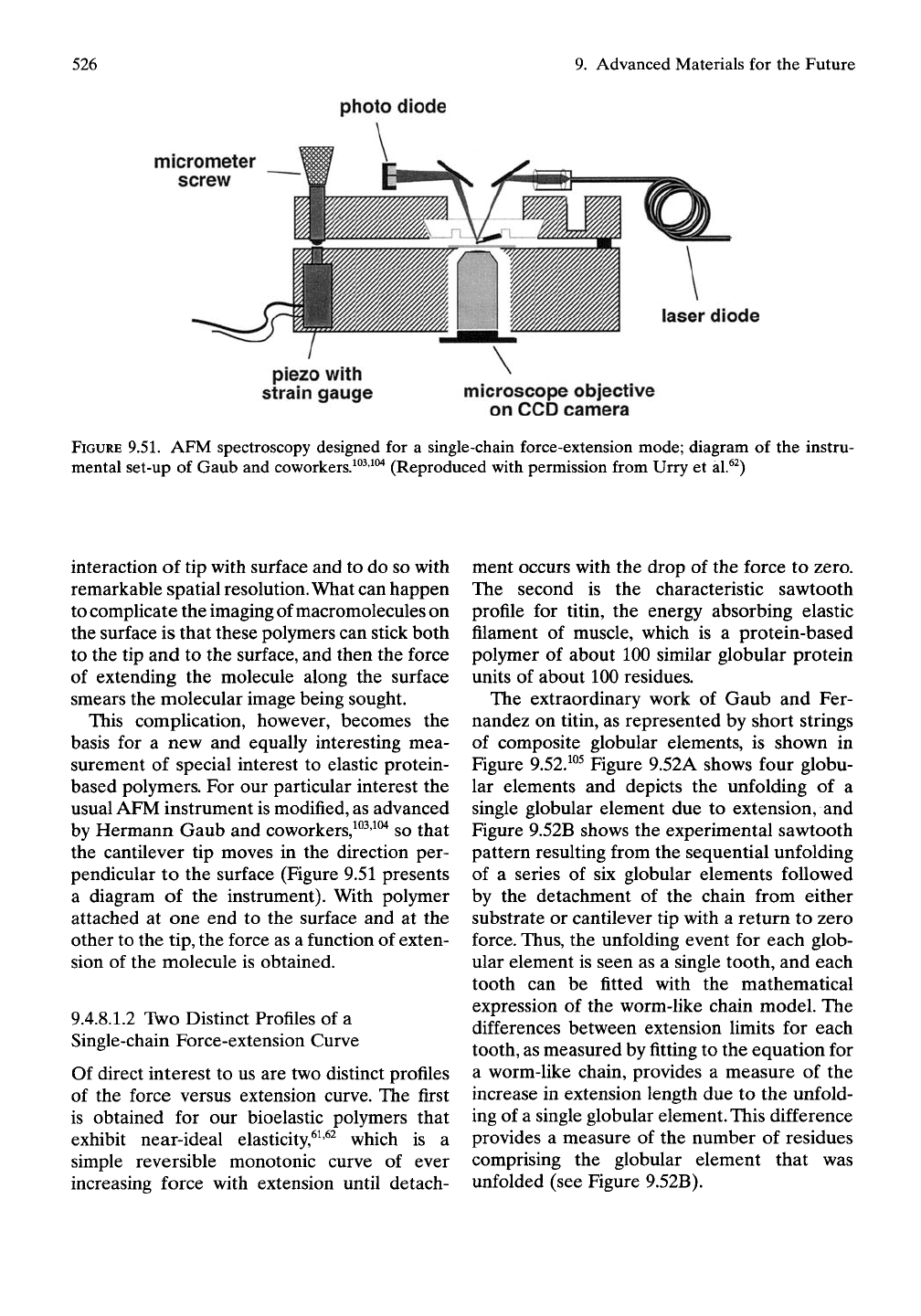
526 9. Advanced Materials for the Future
photo diode
micrometer
screw
laser diode
piezo with
strain gauge
microscope objective
on CCD camera
FIGURE 9.51. AFM spectroscopy designed for a single-chain force-extension mode; diagram of the instru-
mental set-up of Gaub and coworkers.^^^'^^ (Reproduced with permission from Urry et al.^^)
interaction of tip with surface and to do so with
remarkable spatial resolution. What can happen
to complicate the imaging of macromolecules on
the surface is that these polymers can stick both
to the tip and to the surface, and then the force
of extending the molecule along the surface
smears the molecular image being sought.
This compUcation, however, becomes the
basis for a new and equally interesting mea-
surement of special interest to elastic protein-
based polymers. For our particular interest the
usual AFM instrument is modified, as advanced
by Hermann Gaub and coworkers,^^^'^^ so that
the cantilever tip moves in the direction per-
pendicular to the surface (Figure 9.51 presents
a diagram of the instrument). With polymer
attached at one end to the surface and at the
other to the tip, the force as a function of exten-
sion of the molecule is obtained.
9.4.8.1.2 Two Distinct Profiles of a
Single-chain Force-extension Curve
Of direct interest to us are two distinct profiles
of the force versus extension curve. The first
is obtained for our bioelastic polymers that
exhibit near-ideal elasticity,^^'^^ which is a
simple reversible monotonic curve of ever
increasing force with extension until detach-
ment occurs with the drop of the force to zero.
The second is the characteristic sawtooth
profile for titin, the energy absorbing elastic
filament of muscle, which is a protein-based
polymer of about 100 similar globular protein
units of about 100 residues.
The extraordinary work of Gaub and Fer-
nandez on titin, as represented by short strings
of composite globular elements, is shown in
Figure 9.52.^^^ Figure 9.52A shows four globu-
lar elements and depicts the unfolding of a
single globular element due to extension, and
Figure 9.52B shows the experimental sawtooth
pattern resulting from the sequential unfolding
of a series of six globular elements followed
by the detachment of the chain from either
substrate or cantilever tip with a return to zero
force. Thus, the unfolding event for each glob-
ular element is seen as a single tooth, and each
tooth can be fitted with the mathematical
expression of the worm-like chain model. The
differences between extension limits for each
tooth, as measured by fitting to the equation for
a worm-like chain, provides a measure of the
increase in extension length due to the unfold-
ing of a single globular element. This difference
provides a measure of the number of residues
comprising the globular element that was
unfolded (see Figure 9.52B).
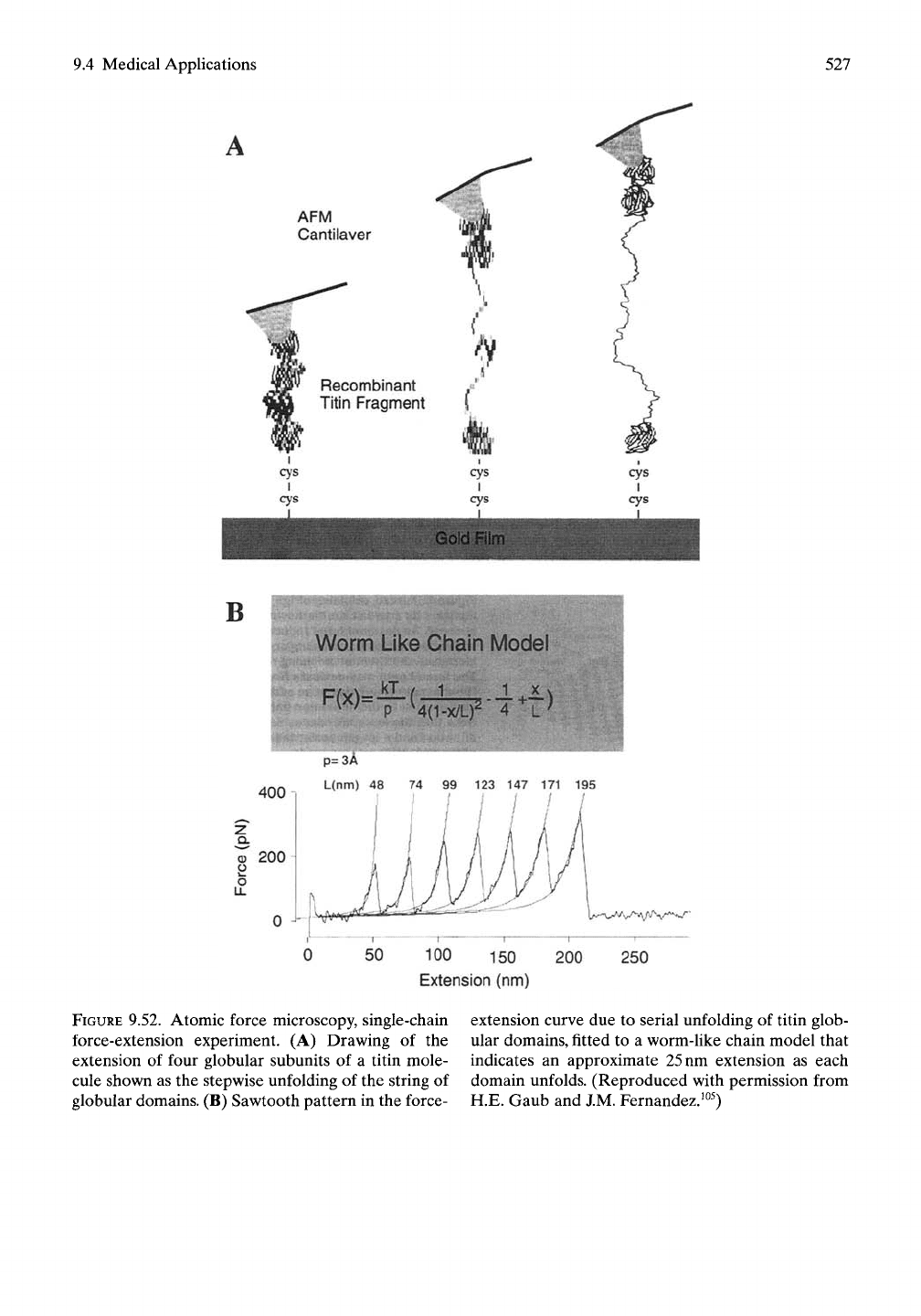
9.4 Medical Applications
527
AFM
Cantilaver
Recombinant
TItIn Fragment
50 100 150 200 250
Extension (nm)
FIGURE
9.52. Atomic force microscopy, single-chain
force-extension experiment. (A) Drawing of the
extension of four globular subunits of a titin mole-
cule shown as the stepwise unfolding of the string of
globular domains. (B) Sawtooth pattern in the force-
extension curve due to serial unfolding of titin glob-
ular domains, fitted to a worm-like chain model that
indicates an approximate
25
nm extension as each
domain unfolds. (Reproduced with permission from
H.E. Gaub and J.M. Fernandez.^°^)
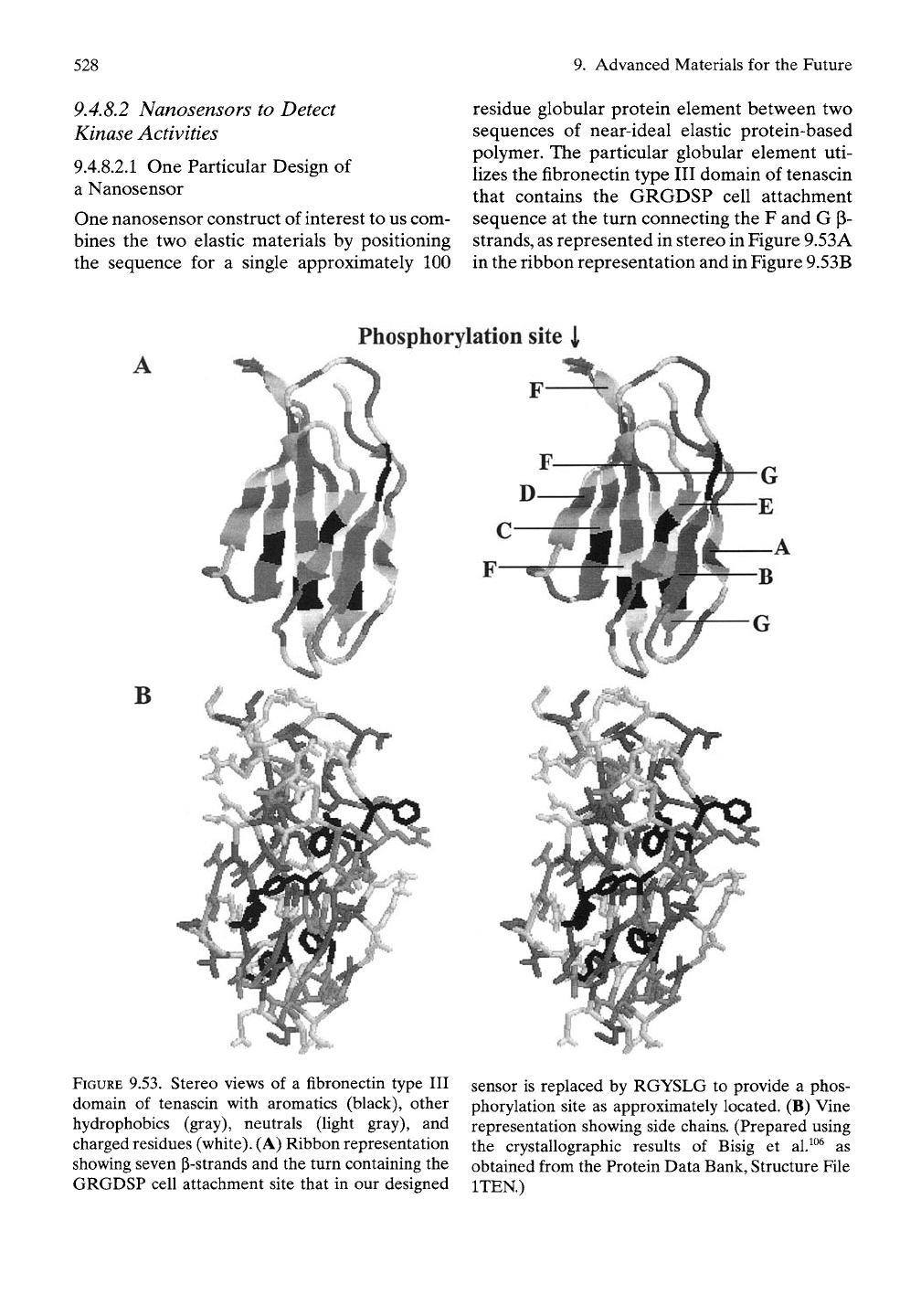
528
9. Advanced Materials for the Future
9.4.8.2 Nanosensors to Detect
Kinase Activities
9.4.8.2.1 One Particular Design of
a Nanosensor
One nanosensor construct of interest to us com-
bines the two elastic materials by positioning
the sequence for a single approximately 100
residue globular protein element between two
sequences of near-ideal elastic protein-based
polymer. The particular globular element uti-
lizes the fibronectin type III domain of tenascin
that contains the GRGDSP cell attachment
sequence at the turn connecting the F and G P-
strands, as represented in stereo in Figure 9.53 A
in the ribbon representation and in Figure 9.53B
Phosphorylation site 4
B
FIGURE 9.53. Stereo views of a fibronectin type III
domain of tenascin with aromatics (black), other
hydrophobics (gray), neutrals (light gray), and
charged residues (white). (A) Ribbon representation
showing seven p-strands and the turn containing the
GRGDSP cell attachment site that in our designed
sensor is replaced by RGYSLG to provide a phos-
phorylation site as approximately located. (B) Vine
representation showing side chains. (Prepared using
the crystallographic results of Bisig et
al.^°^
as
obtained from the Protein Data Bank, Structure File
ITEN.)
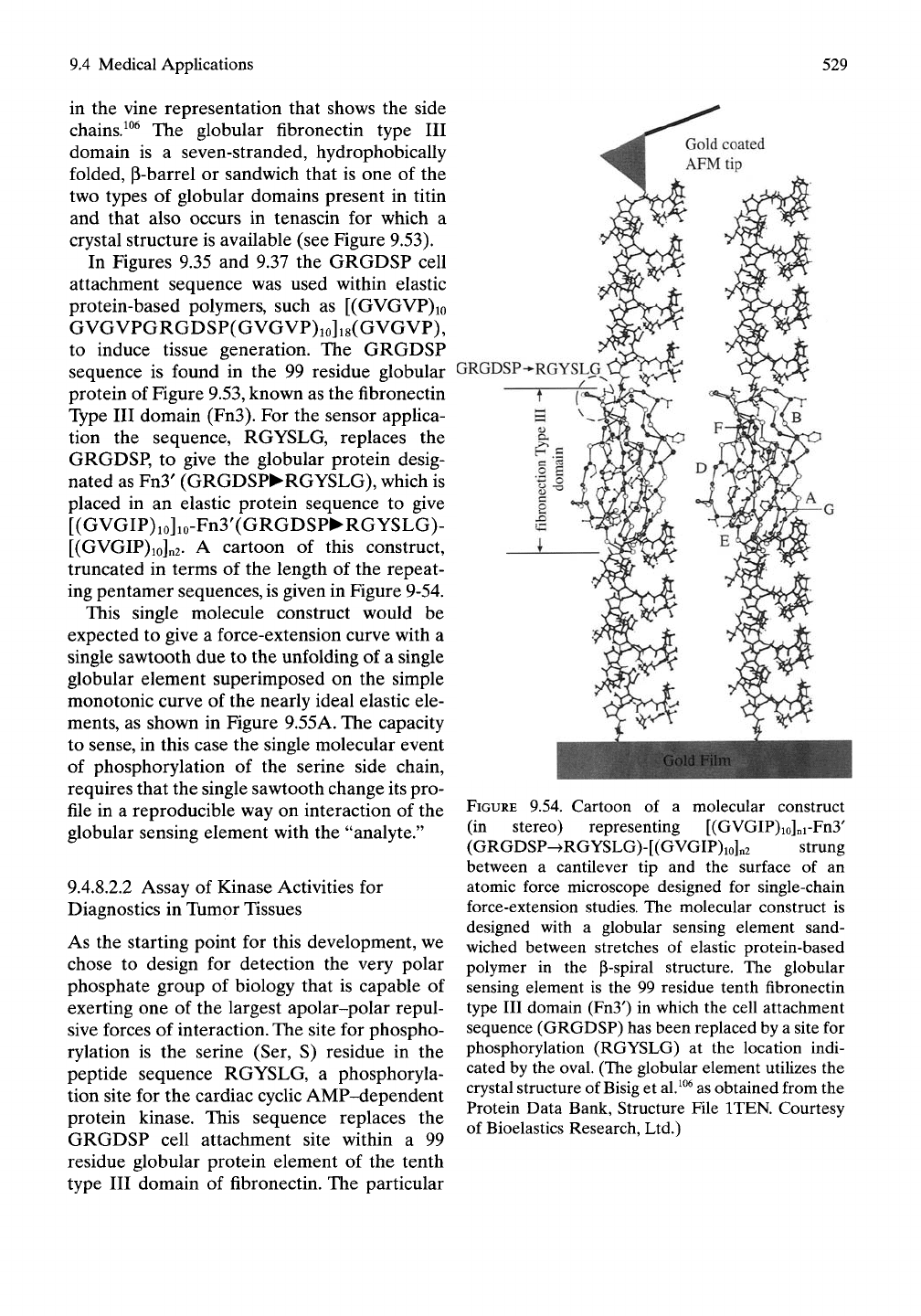
9.4 Medical Applications
529
in the vine representation that shows the side
chains.^^^ The globular fibronectin type III
domain is a seven-stranded, hydrophobically
folded, P-barrel or sandwich that is one of the
two types of globular domains present in titin
and that also occurs in tenascin for which a
crystal structure is available (see Figure 9.53).
In Figures 9.35 and 9.37 the GRGDSP cell
attachment sequence was used within elastic
protein-based polymers, such as [(GVGVP)io
GVGVPGRGDSP(GVGVP)io]i8(GVGVP),
to induce tissue generation. The GRGDSP
sequence is found in the 99 residue globular
protein of Figure 9.53, known as the fibronectin
Type III domain (Fn3). For the sensor apphca-
tion the sequence, RGYSLG, replaces the
GRGDSP, to give the globular protein desig-
nated as Fn3' (GRGDSP^RGYSLG), which is
placed in an elastic protein sequence to give
[(GVGIP)io]io-Fn3'(GRGDSP^RGYSLG)-
[(GVGIP)io]n2- A cartoon of this construct,
truncated in terms of the length of the repeat-
ing pentamer sequences, is given in Figure 9-54.
This single molecule construct would be
expected to give a force-extension curve with a
single sawtooth due to the unfolding of a single
globular element superimposed on the simple
monotonic curve of the nearly ideal elastic ele-
ments, as shown in Figure 9.55A. The capacity
to sense, in this case the single molecular event
of phosphorylation of the serine side chain,
requires that the single sawtooth change its pro-
file in a reproducible way on interaction of the
globular sensing element with the "analyte."
9.4.8.2.2 Assay of Kinase Activities for
Diagnostics in Tumor Tissues
As the starting point for this development, we
chose to design for detection the very polar
phosphate group of biology that is capable of
exerting one of the largest apolar-polar repul-
sive forces of interaction. The site for phospho-
rylation is the serine (Ser, S) residue in the
peptide sequence RGYSLG, a phosphoryla-
tion site for the cardiac cyclic AMP-dependent
protein kinase. This sequence replaces the
GRGDSP cell attachment site within a 99
residue globular protein element of the tenth
type III domain of fibronectin. The particular
GRGDSP-^RGYSLG
FIGURE
9.54. Cartoon of a molecular construct
(in stereo) representing [(GVGIP)io]ni-Fn3'
(GRGDSP->RGYSLG)-[(GVGIP)io]n2 strung
between a cantilever tip and the surface of an
atomic force microscope designed for single-chain
force-extension studies. The molecular construct is
designed with a globular sensing element sand-
wiched between stretches of elastic protein-based
polymer in the p-spiral structure. The globular
sensing element is the 99 residue tenth fibronectin
type III domain (Fn3') in which the cell attachment
sequence (GRGDSP) has been replaced by a site for
phosphorylation (RGYSLG) at the location indi-
cated by the oval. (The globular element utilizes the
crystal structure of
Bisig
et
al.^^^
as obtained from the
Protein Data Bank, Structure File ITEN. Courtesy
of Bioelastics Research, Ltd.)
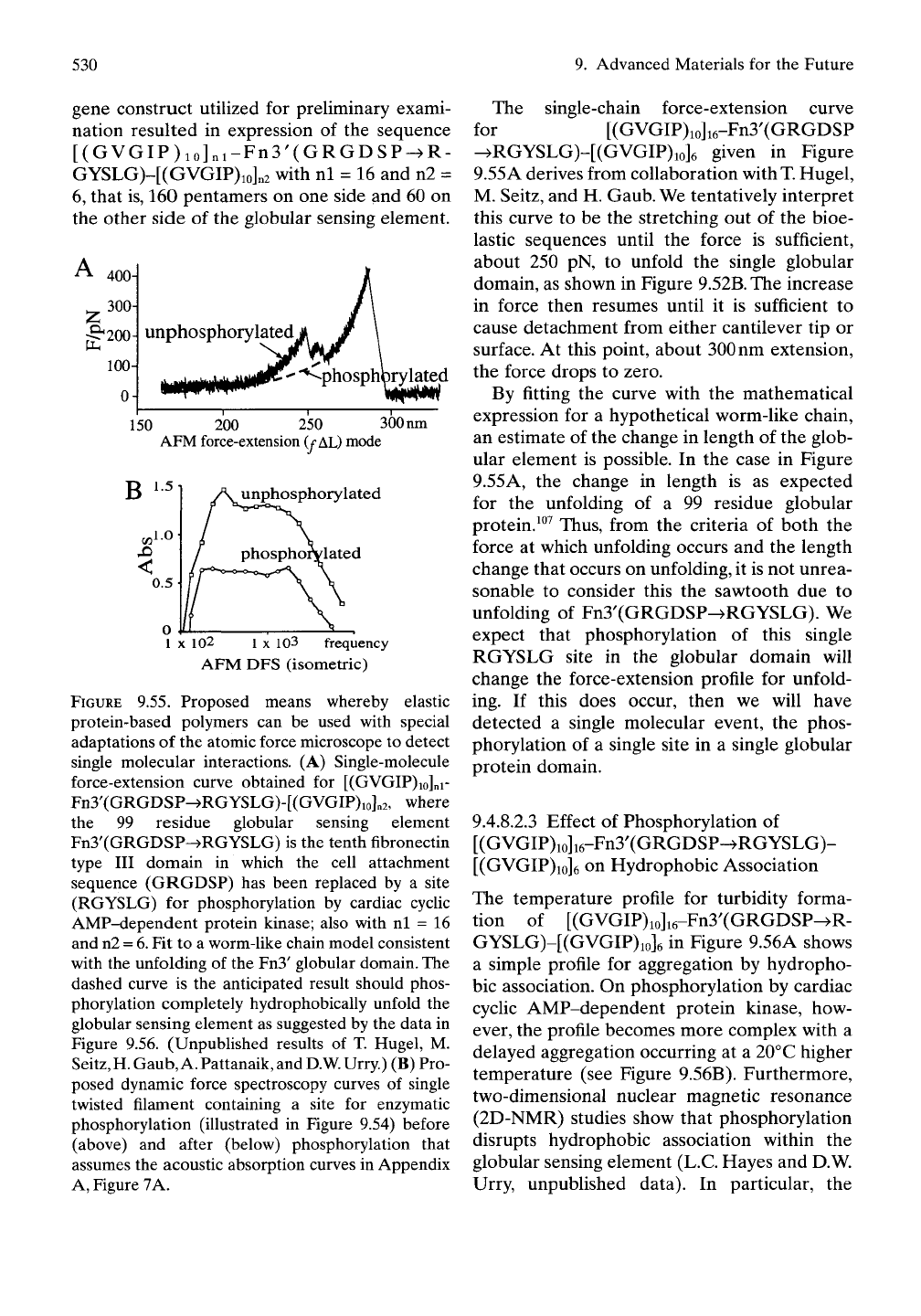
530
9. Advanced Materials for the Future
gene construct utilized for preliminary exami-
nation resulted in expression of the sequence
[(GVGIP)io]ni-Fn3'(GRGDSP->R-
GYSLG)-[(GVGIP)io]n2 with nl = 16 and n2 =
6, that is, 160 pentamers on one side and 60 on
the other side of the globular sensing element.
^ 400-
^300.
-$"200-1 unphosphorylated
100-
0
150 200 250 300 nm
AFM force-extension (fAL) mode
unphosphorylated
phosphorylated
1 X 103 frequency
AFM DFS (isometric)
FIGURE 9.55. Proposed means whereby elastic
protein-based polymers can be used with special
adaptations of the atomic force microscope to detect
single molecular interactions. (A) Single-molecule
force-extension curve obtained for [(GVGIP)io]ni-
Fn3'(GRGDSP-^RGYSLG)-[(GVGIP)io]n2, where
the 99 residue globular sensing element
Fn3'(GRGDSP-^RGYSLG) is the tenth fibronectin
type III domain in which the cell attachment
sequence (GRGDSP) has been replaced by a site
(RGYSLG) for phosphorylation by cardiac cyclic
AMP-dependent protein kinase; also with nl = 16
and n2
=
6.
Fit to a worm-like chain model consistent
with the unfolding of the Fn3' globular domain. The
dashed curve is the anticipated result should phos-
phorylation completely hydrophobically unfold the
globular sensing element as suggested by the data in
Figure 9.56. (Unpublished results of T. Hugel, M.
Seitz,
H.
Gaub,
A.
Pattanaik, and
D.W.
Urry) (B) Pro-
posed dynamic force spectroscopy curves of single
twisted filament containing a site for enzymatic
phosphorylation (illustrated in Figure 9.54) before
(above) and after (below) phosphorylation that
assumes the acoustic absorption curves in Appendix
A, Figure 7A.
The single-chain force-extension curve
for [(GVGIP)io]i6-Fn3'(GRGDSP
-^RGYSLG)-[(GVGIP)io]6 given in Figure
9.55A derives from collaboration withT. Hugel,
M. Seitz, and H. Gaub. We tentatively interpret
this curve to be the stretching out of the bioe-
lastic sequences until the force is sufficient,
about 250 pN, to unfold the single globular
domain, as shown in Figure 9.52B. The increase
in force then resumes until it is sufficient to
cause detachment from either cantilever tip or
surface. At this point, about
300
nm extension,
the force drops to zero.
By fitting the curve with the mathematical
expression for a hypothetical worm-like chain,
an estimate of the change in length of the glob-
ular element is possible. In the case in Figure
9.55A, the change in length is as expected
for the unfolding of a 99 residue globular
protein.^^^ Thus, from the criteria of both the
force at which unfolding occurs and the length
change that occurs on unfolding, it is not unrea-
sonable to consider this the sawtooth due to
unfolding of Fn3'(GRGDSP^RGYSLG). We
expect that phosphorylation of this single
RGYSLG site in the globular domain will
change the force-extension profile for unfold-
ing. If this does occur, then we will have
detected a single molecular event, the phos-
phorylation of a single site in a single globular
protein domain.
9.4.8.2.3 Effect of Phosphorylation of
[(GVGIP)io]i6-Fn3'(GRGDSP->RGYSLG)-
[(GVGIP)io]6 on Hydrophobic Association
The temperature profile for turbidity forma-
tion of [(GVGIP)io]i6-Fn3'(GRGDSP->R-
GYSLG)-[(GVGIP)io]6 in Figure 9.56A shows
a simple profile for aggregation by hydropho-
bic association. On phosphorylation by cardiac
cyclic AMP-dependent protein kinase, how-
ever, the profile becomes more complex with a
delayed aggregation occurring at a 20°C higher
temperature (see Figure 9.56B). Furthermore,
two-dimensional nuclear magnetic resonance
(2D-NMR) studies show that phosphorylation
disrupts hydrophobic association within the
globular sensing element (L.C. Hayes and D.W.
Urry, unpublished data). In particular, the
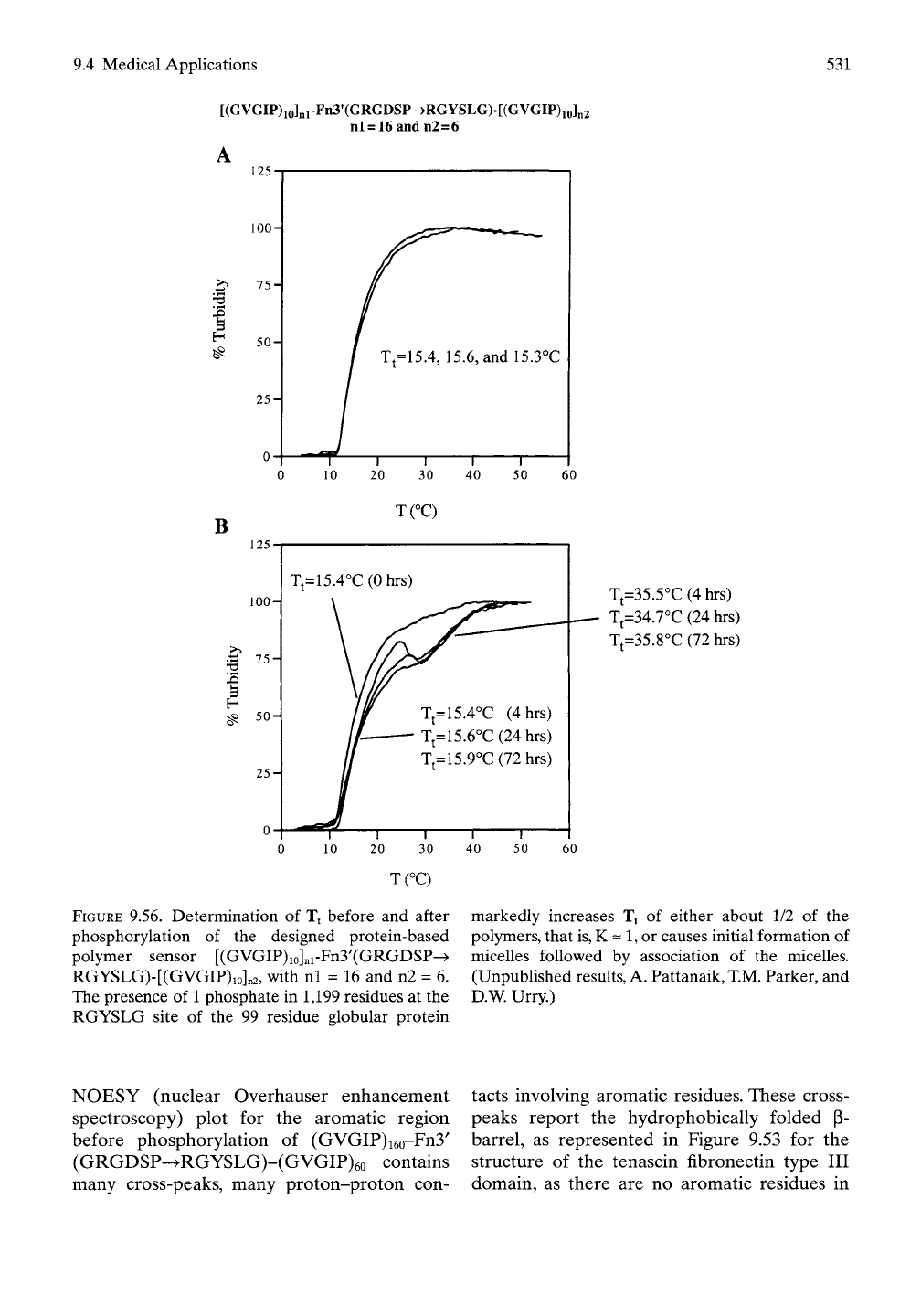
9.4 Medical Applications
531
[(GVGIP)io]„i-Fn3'(GRGDSP^RGYSLG)-[(GVGIP)io]n2
nl
=
16andn2 = 6
125-
lOOH
B
TCO
125-
100 H
Tj=15.4°C(0hrs)
Tj=15.4°C (4hrs)
Tt=15.6°C(24hrs)
Tj=15.9°C(72hrs)
Tt=35.5°C (4 hrs)
Tt=34.7°C (24 hrs)
Tj=35.8°C (72 hrs)
20 30
T(°C)
FIGURE 9.56. Determination of Tt before and after
phosphorylation of the designed protein-based
polymer sensor [(GVGIP)io]ni-Fn3'(GRGDSP^
RGYSLG)-[(GVGIP)io]n2, with nl = 16 and n2 = 6.
The presence of
1
phosphate in 1,199 residues at the
RGYSLG site of the 99 residue globular protein
50
markedly increases Tt of either about 1/2 of the
polymers, that
is,
K ~
1,
or causes initial formation of
micelles followed by association of the micelles.
(UnpubHshed
results,
A.
Pattanaik,
T.M.
Parker, and
D.W. Urry.)
NOESY (nuclear Overhauser enhancement
spectroscopy) plot for the aromatic region
before phosphorylation of (GVGIP)i6o-Fn3'
(GRGDSP-^RGYSLG)-(GVGIP)6o contains
many cross-peaks, many proton-proton con-
tacts involving aromatic residues. These cross-
peaks report the hydrophobically folded p-
barrel, as represented in Figure 9.53 for the
structure of the tenascin fibronectin type III
domain, as there are no aromatic residues in
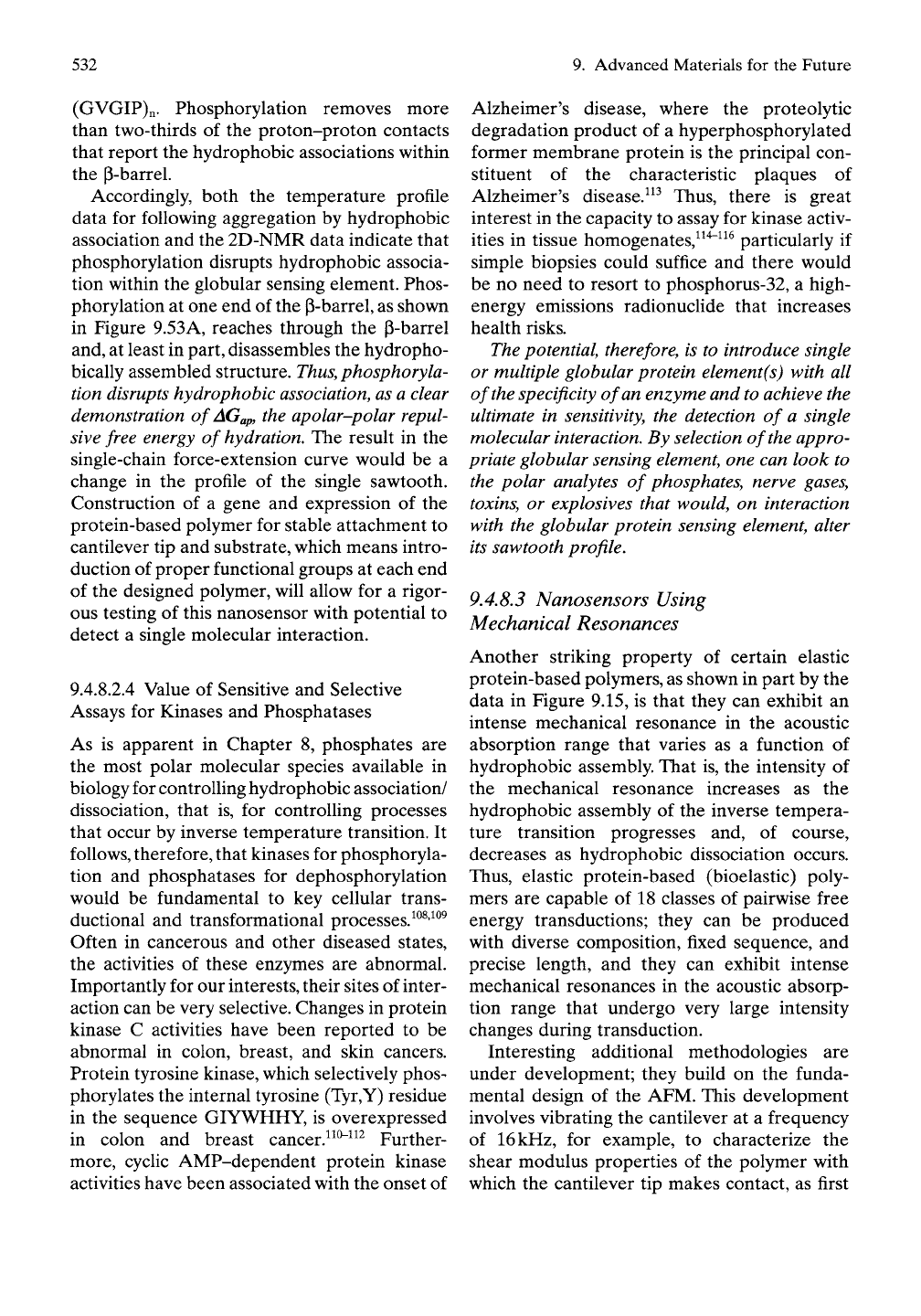
532
9. Advanced Materials for the Future
(GVGIP)n. Phosphorylation removes more
than two-thirds of the proton-proton contacts
that report the hydrophobic associations within
the p-barrel.
Accordingly, both the temperature profile
data for following aggregation by hydrophobic
association and the 2D-NMR data indicate that
phosphorylation disrupts hydrophobic associa-
tion within the globular sensing element. Phos-
phorylation at one end of the p-barrel, as shown
in Figure 9.53A, reaches through the P-barrel
and, at least in part, disassembles the hydropho-
bically assembled structure. Thus, phosphoryla-
tion disrupts hydrophobic association, as a clear
demonstration of
AGap,
the apolar-polar repul-
sive free energy of hydration. The result in the
single-chain force-extension curve would be a
change in the profile of the single sawtooth.
Construction of a gene and expression of the
protein-based polymer for stable attachment to
cantilever tip and substrate, which means intro-
duction of proper functional groups at each end
of the designed polymer, will allow for a rigor-
ous testing of this nanosensor with potential to
detect a single molecular interaction.
9.4.8.2.4 Value of Sensitive and Selective
Assays for Kinases and Phosphatases
As is apparent in Chapter 8, phosphates are
the most polar molecular species available in
biology for controlling hydrophobic association/
dissociation, that is, for controlling processes
that occur by inverse temperature transition. It
follows, therefore, that kinases for phosphoryla-
tion and phosphatases for dephosphorylation
would be fundamental to key cellular trans-
ductional and transformational processes. ^^^'^^^
Often in cancerous and other diseased states,
the activities of these enzymes are abnormal.
Importantly for our interests, their sites of inter-
action can be very selective. Changes in protein
kinase C activities have been reported to be
abnormal in colon, breast, and skin cancers.
Protein tyrosine kinase, which selectively phos-
phorylates the internal tyrosine (Tyr,Y) residue
in the sequence GIYWHHY, is overexpressed
in colon and breast cancer.^^^^^^ Further-
more, cycUc AMP-dependent protein kinase
activities have been associated with the onset of
Alzheimer's disease, where the proteolytic
degradation product of a hyperphosphorylated
former membrane protein is the principal con-
stituent of the characteristic plaques of
Alzheimer's disease.^^^ Thus, there is great
interest in the capacity to assay for kinase activ-
ities in tissue homogenates,^^"^^^^ particularly if
simple biopsies could suffice and there would
be no need to resort to phosphorus-32, a high-
energy emissions radionuclide that increases
health risks.
The potential, therefore, is to introduce single
or multiple globular protein element(s) with all
of the specificity of an enzyme and to achieve the
ultimate in sensitivity, the detection of a single
molecular interaction. By selection of the appro-
priate globular sensing element, one can look to
the polar analytes of phosphates, nerve gases,
toxins, or explosives that
would,
on interaction
with the globular protein sensing element, alter
its sawtooth profile.
9.4.8.3 Nanosensors Using
Mechanical Resonances
Another striking property of certain elastic
protein-based polymers, as shown in part by the
data in Figure 9.15, is that they can exhibit an
intense mechanical resonance in the acoustic
absorption range that varies as a function of
hydrophobic assembly. That is, the intensity of
the mechanical resonance increases as the
hydrophobic assembly of the inverse tempera-
ture transition progresses and, of course,
decreases as hydrophobic dissociation occurs.
Thus,
elastic protein-based (bioelastic) poly-
mers are capable of 18 classes of pairwise free
energy transductions; they can be produced
with diverse composition, fixed sequence, and
precise length, and they can exhibit intense
mechanical resonances in the acoustic absorp-
tion range that undergo very large intensity
changes during transduction.
Interesting additional methodologies are
under development; they build on the funda-
mental design of the AFM. This development
involves vibrating the cantilever at a frequency
of
16
kHz, for example, to characterize the
shear modulus properties of the polymer with
which the cantilever tip makes contact, as first
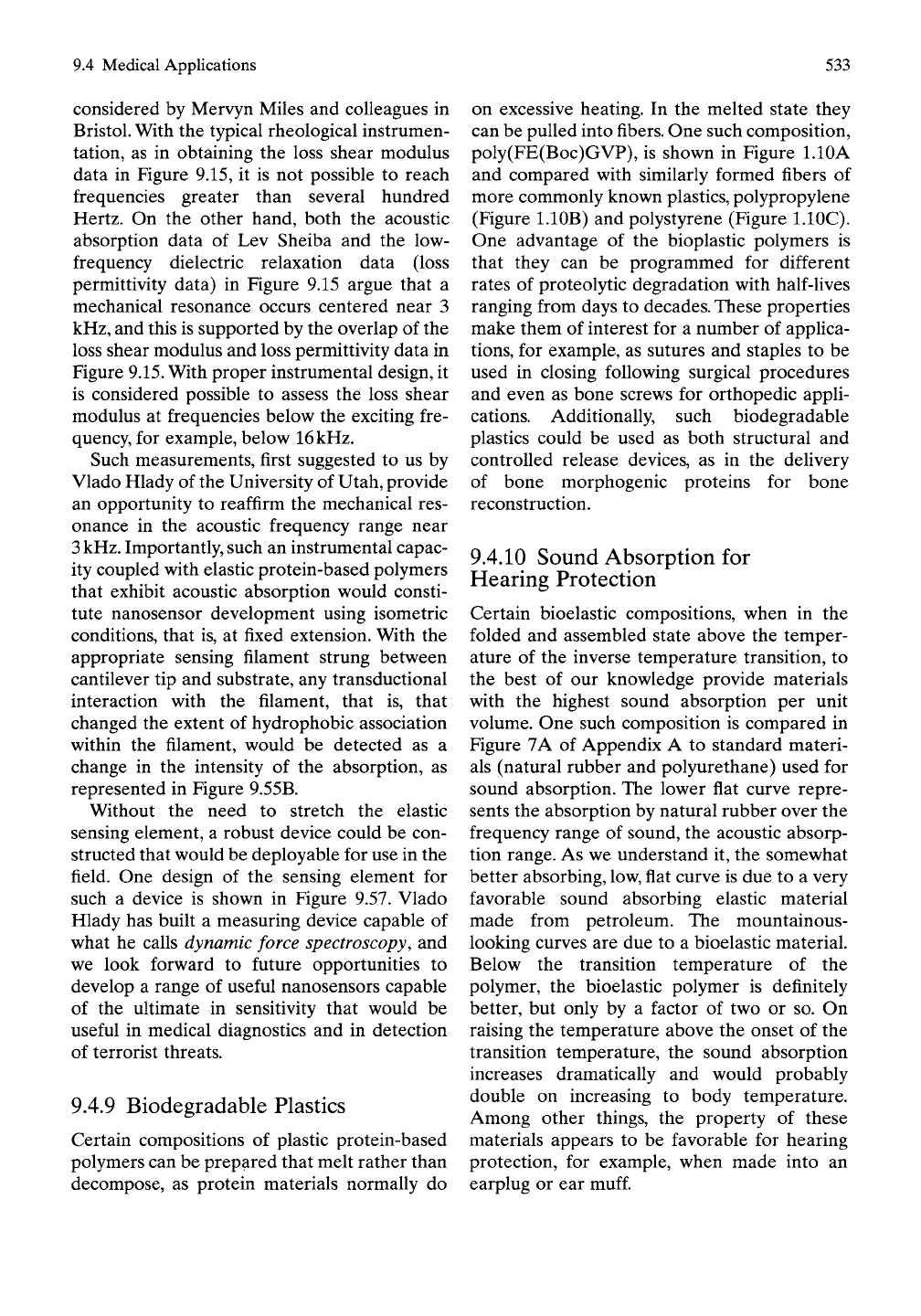
9.4 Medical Applications
533
considered by Mervyn Miles and colleagues in
Bristol. With the typical rheological instrumen-
tation, as in obtaining the loss shear modulus
data in Figure 9.15, it is not possible to reach
frequencies greater than several hundred
Hertz. On the other hand, both the acoustic
absorption data of Lev Sheiba and the low-
frequency dielectric relaxation data (loss
permittivity data) in Figure 9.15 argue that a
mechanical resonance occurs centered near 3
kHz, and this is supported by the overlap of the
loss shear modulus and loss permittivity data in
Figure 9.15. With proper instrumental design, it
is considered possible to assess the loss shear
modulus at frequencies below the exciting fre-
quency, for example, below
16
kHz.
Such measurements, first suggested to us by
Vlado Hlady of the University of Utah, provide
an opportunity to reaffirm the mechanical res-
onance in the acoustic frequency range near
3 kHz. Importantly, such an instrumental capac-
ity coupled with elastic protein-based polymers
that exhibit acoustic absorption would consti-
tute nanosensor development using isometric
conditions, that is, at fixed extension. With the
appropriate sensing filament strung between
cantilever tip and substrate, any transductional
interaction with the filament, that is, that
changed the extent of hydrophobic association
within the filament, would be detected as a
change in the intensity of the absorption, as
represented in Figure 9.55B.
Without the need to stretch the elastic
sensing element, a robust device could be con-
structed that would be deployable for use in the
field. One design of the sensing element for
such a device is shown in Figure 9.57. Vlado
Hlady has built a measuring device capable of
what he calls dynamic force spectroscopy, and
we look forward to future opportunities to
develop a range of useful nanosensors capable
of the ultimate in sensitivity that would be
useful in medical diagnostics and in detection
of terrorist threats.
9.4.9 Biodegradable Plastics
Certain compositions of plastic protein-based
polymers can be prepared that melt rather than
decompose, as protein materials normally do
on excessive heating. In the melted state they
can be pulled into fibers. One such composition,
poly(FE(Boc)GVP), is shown in Figure I.IOA
and compared with similarly formed fibers of
more commonly known plastics, polypropylene
(Figure 1.1 OB) and polystyrene (Figure I.IOC).
One advantage of the bioplastic polymers is
that they can be programmed for different
rates of proteolytic degradation with half-lives
ranging from days to decades. These properties
make them of interest for a number of applica-
tions,
for example, as sutures and staples to be
used in closing following surgical procedures
and even as bone screws for orthopedic appli-
cations. Additionally, such biodegradable
plastics could be used as both structural and
controlled release devices, as in the delivery
of bone morphogenic proteins for bone
reconstruction.
9.4.10 Sound Absorption for
Hearing Protection
Certain bioelastic compositions, when in the
folded and assembled state above the temper-
ature of the inverse temperature transition, to
the best of our knowledge provide materials
with the highest sound absorption per unit
volume. One such composition is compared in
Figure 7A of Appendix A to standard materi-
als (natural rubber and polyurethane) used for
sound absorption. The lower flat curve repre-
sents the absorption by natural rubber over the
frequency range of sound, the acoustic absorp-
tion range. As we understand it, the somewhat
better absorbing, low, flat curve is due to a very
favorable sound absorbing elastic material
made from petroleum. The mountainous-
looking curves are due to a bioelastic material.
Below the transition temperature of the
polymer, the bioelastic polymer is definitely
better, but only by a factor of two or so. On
raising the temperature above the onset of the
transition temperature, the sound absorption
increases dramatically and would probably
double on increasing to body temperature.
Among other things, the property of these
materials appears to be favorable for hearing
protection, for example, when made into an
earplug or ear
muff.
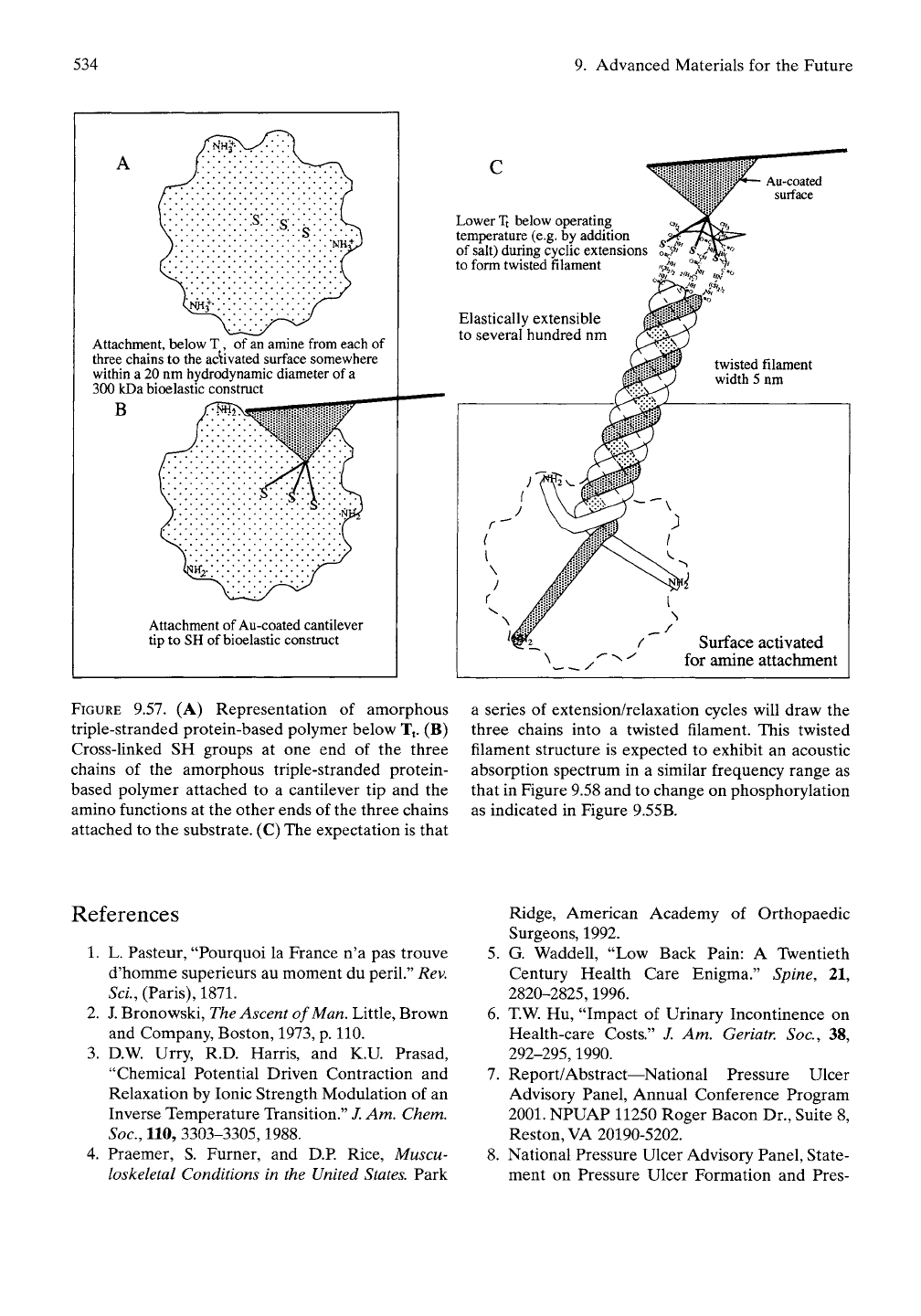
534
9. Advanced Materials for the Future
Attachment, below T , of
an
amine from each of
three chains to the activated surface somewhere
within a 20 nm hydrodynamic diameter of
a
300 kDa bioelastic construct
B
Attachment of Au-coated cantilever
tip to SH of bioelastic construct
Lower
Tt
below operating
temperature
(e.g.
by addition
of
salt)
during cyclic extensions
to form twisted filament
Elastically extensible
to several hundred nm
FIGURE
9.57. (A) Representation of amorphous
triple-stranded protein-based polymer below Tt. (B)
Cross-linked SH groups at one end of the three
chains of the amorphous triple-stranded protein-
based polymer attached to a cantilever tip and the
amino functions at the other ends of the three chains
attached to the substrate. (C) The expectation is that
twisted filament
width
5
nm
r""
/
i
\
)
r
/
; ^
( \
J \
^1
\
?2V
^ ^
^^
pil
^^i^v^
-"]
/
-^y
1
I
Surface activated
for amine attachment
a series of extension/relaxation cycles will draw the
three chains into a twisted filament. This twisted
filament structure is expected to exhibit an acoustic
absorption spectrum in a similar frequency range as
that in Figure 9.58 and to change on phosphorylation
as indicated in Figure 9.55B.
References
1.
L. Pasteur, "Pourquoi la France n'a pas trouve
d'homme superieurs au moment du peril." Rev.
5d., (Paris), 1871.
2.
J. Bronowski, The Ascent of
Man.
Little, Brown
and Company, Boston, 1973, p. 110.
3.
D.W. Urry, R.D. Harris, and K.U. Prasad,
"Chemical Potential Driven Contraction and
Relaxation by Ionic Strength Modulation of an
Inverse Temperature Transition." /. Am. Chem.
Soc, 110, 3303-3305,1988.
4.
Praemer, S. Furner, and D.P. Rice, Muscu-
loskeletal Conditions in the United States. Park
Ridge, American Academy of Orthopaedic
Surgeons, 1992.
5.
G. Waddell, "Low Back Pain: A Twentieth
Century Health Care Enigma." Spine, 21,
2820-2825,1996.
6. T.W. Hu, "Impact of Urinary Incontinence on
Health-care Costs." /. Am. Geriatr. Soc, 38,
292-295,1990.
7.
Report/Abstract—National Pressure Ulcer
Advisory Panel, Annual Conference Program
2001.
NPUAP 11250 Roger Bacon Dr., Suite 8,
Reston,VA 20190-5202.
8. National Pressure Ulcer Advisory Panel, State-
ment on Pressure Ulcer Formation and Pres-
